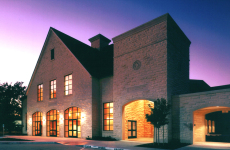Last August I interviewed for a one-year visiting professor position at Texas A&M’s political science department.[1] The position involved teaching three courses each term in introductory American Politics and Texas politics.
The courses were large lectures, with 300 students apiece without teaching assistants. The lacks of TAs surprised me, because a team of several graduate students teach several discussion sections to provide opportunities for closer engagement. But A&M department policy provided no TAs, leaving the professor with nearly 1,000 students every term.[2]
How does a professor teach under these circumstances? It’s difficult, but the traditional lecture does offer several advantages for students over merely picking up a book on the subject.
Through developing my own lectures, as well as working as a TA in more than a dozen large lecture courses, I’ve developed three overlapping and informal rules of thumb to maximize the ability of a basic lecture hall class to educate. I offer the following suggestions both to prospective instructors and to students and parents who wonder if large lectures can actually accomplish anything.
- Make it worth students’ time to come.
- Foster interaction with students in the margins around class
- Directly engage students with questions and small activities during lecture
Make it worth students’ time to come:
This is the most generic of the three points and the second two certainly pertain to it as well. But in general, it means that an instructor should be preparing thoughtful, well-organized lectures. I usually break my courses into week-long segments and write the week’s two or three lectures at the same time to ensure that their overall points build together well. Each lecture has two or three basic points that should be signposted at the beginning with a slide and summed up at the end with a summary slide. Every slide has one clear objective. Every slide is simple, with a clear take-home point that students can copy. Graphics, pictures and strategically placed jokes and questions help break up the monotony.
I type up and print out notes for my slides. On my notes, I type the basic point for every slide in bold, and a more detailed explanation in regular text underneath. Usually, I talk from memory, but I keep my notes close to keep me on task and moving at a useful clip.
I at least review my points before class and formally practice if I have the chance – one of the most dynamic professors I know, Michigan’s Arthur “Skip” Lupia, always practices his lectures and conference presentations multiple times to achieve the seamless transitions and flawless timing that are his calling cards. Even if I don’t have the chance to give a formal practice, the act of writing the lecture, then typing the notes helps me think about how well the points go together. It also helps me get a sense of the time that each slide takes – few things annoy me more than a professor who comes into a 40-minute class attempting to present 60 slides.
Lectures should complement outside readings but shouldn’t parrot them, to both give students incentive to come to lecture and extend the subject matter under discussion. For example, when I lecture on the definition of democracy, I’ll usually outline one or two of the definitions discussed by the two articles I assign on the subject. However, I’ll also include an additional definition or two to give students who came to lecture a deeper knowledge of the subject — which incidentally will often help them on the test.
Interact with students immediately before and after class:
To this point, I’ve focused primarily on talking at students, not talking with them – good teaching involves both. A lecture is more set up around the former, but to be truly effective it needs to incorporate the latter. But how does a good instructor schedule in student interaction with a tight schedule and 200 students in the class?
Usually there are 10 minutes before class and 10 minutes after class. A professor who doesn’t have to dash from classroom to classroom across campus in that narrow can use those minutes to get to know students a bit. Don’t hide behind the podium. Meander a bit in front of the classroom. Say “good morning” to students in the front row. Better yet – hang out on one side of the classroom or in the back and say hello to students back there. If it’s the first or second day, introduce yourself and ask for names. Finding someone with a witty T-shirt or amusing sticker on his laptop can lead to an amusing conversation.
I often find useful to connect with students is while we’re stuck waiting in the hallway for the last class to get out. A friendly greeting and good-natured complaint about being cooped up in the hallway introduces you to students in a slightly less hierarchical manner. The entire idea is to increase the comfort that students have with you and increase the chances they might stick up their hands during class.[3]
Interact with students during class:
A large lecture hall isn’t a 10-person seminar, so a robust discussion isn’t likely to happen, but it is possible to draw out students during a large lecture as well. First, set the tone – step out from behind the podium and speak to the class, not your notes, the lectern or the board. I’ll often catch myself speaking to a slide, stop, say out loud “don’t speak to the board, speak to your class” and turn around. At worst, it was a short break between slides to help everyone refocus, at best it gets a bit of a chuckle. And in any case it reconnects professor and students.
Make eye contact with students. This helps me tune in to individuals in the class and read whether they’re bored, confused, updating their foursquare account or dialed into the lecture topic. When I ask questions, I can adjust my question to their reactions. The connection also lets students know I’m paying attention to them. Finally, when calling on students in class, ask them to say their names. You’ll start to get to know at least a few of them and it will make an impression.
The second major focus of interaction during the lecture is to ask questions. Most questions shouldn’t be complicated – a sin that I and most other professors commit many times during the lecture. Ask simple questions, with yes-no answers if necessary, before moving on to more complicated ones.
Here are some handy tactics to use when asking questions during class:
- “Does this make sense?” Pause at the end of every three or four slides and check in with the class. If you can get at least a modicum of head nods and a mumbled “yeah,” then you’re doing OK. If you get a whole class staring at you looking like deer caught in headlights, the answer is “no.” Follow up by asking them what they don’t understand. If you get an answer, proceed. If not, I ask if it would be helpful to go over the point again (here I usually make a mental note to revise my notes or rethink the slides for future classes).
- Ask questions with simple choices to review a section. Another tactic is to ask students to apply the knowledge you have just gone over every several slides. Say, for example, that I’ve just outlined the differences between different types of electoral systems. I might give students a few examples of countries we’re studying and ask my students to identify the electoral system as proportional or majoritarian. If they get the answers right, I know I’m getting my point across, if they don’t, we’ll review the logic and try again. I also follow up to ask them what sort of thought process they are using. It’s good to know if a student who gets an incorrect answer is using a thoughtful process to get there (and sometimes a “wrong” answer isn’t wrong at all).Have students predict the next slide. Sometimes there are natural implications of the logic you’re discussing. Sometimes I’ll post a leading question at the end of one slide and ask for an answer. This invites the class to help me move the lecture along, and again acts as a check on whether the class is with me.
- Consider using I-clickers or other technology to automate responses. With these sorts of systems, students have devices that allow them to punch a button to answer a question. Rossie Hutchinson, a lecturer I worked with at Michigan, used this system to great effect in a 200-person research design course she taught. At strategic intervals during class, she’d post a multiple-choice question reviewing the concept she’d had just introduced. Students earned points for answering the question, so they could answer without worrying about whether or not they were right. The software then showed the results, and we could see at a glance what percentage of the class understood the concept. She then would review or move on as necessary. As a bonus, this feature also awards class participation points and gives students an incentive to show up to lecture.
- Use a “minute essay.” At the end of a relevant portion of the lecture, have students write down their thoughts or ideas on a specific question for one minute. Then call on random students to share their ideas. This avoids putting students on the spot without giving them time to gather their thoughts, but also spreads discussion and participation to students who won’t necessarily raise their hands to speak.
Finally, good professors are always open to questions from students. When a hand goes up, acknowledge it and use it.
Large lectures will never be the same as small seminars – especially when students don’t have the opportunity to work in small discussion sections as in Texas A&M’s current set up. However, with proper preparation and a conscious use of several simple tactics, it is possible to significantly increase student-professor interaction to improve both the teaching and the learning experience.
[1] For the record, I didn’t get the job. I wasn’t particularly bitter, though I obtain unusual satisfaction when Rice’s football team rushed for 306 yards on A&M’s hapless defense a few weeks later.
[2] For what it’s worth, I suspect this policy will be changing soon. A&M’s political science department is getting a new chair in the fall with a reputation for shaking things up.
[3] Note, this is a fine line. Professors want to keep some professional distance from students to keep authority in the classroom. But too great of distance shuts down the opportunity for intellectual exchange.

























